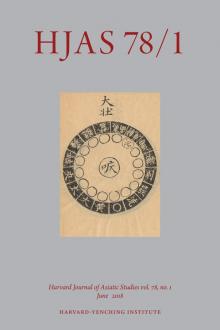June 2018
Ge Zhongxuan 葛中選, “Da zhuang” 大壯, in Tailü 泰律, 12 juan 卷 in 6 vols. (ce 冊) (n.p.: Yunnan tushuguan, 1914), v. 3, j. 5, p. 2a (seq. 3), http://listview.lib.harvard.edu/lists/drs-435010161. Photo: Imaging Department © President and Fellows of Harvard College.
Editorial Preface
Articles
New Scripts for All Sounds
Cosmology and Universal Phonetic Notation Systems in Late Imperial China
I argue that cosmological methods, and the debates they inspired, were a major source of innovation in phonological scholarship during the late Ming. Sixteenth- and seventeenth-century scholars strove to document the scope of possible sounds existing in the universe. Realizing the Chinese script was insufficient to fully record them, they explored new notation systems to comprehensively describe sound. Although competing contemporaneous approaches called for analyzing phonology according to regional or historical differences, Ming cosmologists asserted a significant alternative that they believed overcame limits of place and time. This case study suggests a need to rethink the impact of Ming scholars on Chinese intellectual history and on the history of writing in China.
象數學是明末音韻和文字學很重要的一部分。十六、十七世紀的學者試圖通過象數的方法記錄宇宙裡所有可能存在的聲音。因為漢字無法完全記錄所有的聲音,學者便開始探討漢字以外的方法來記錄聲音。這篇論文對以前被忽略的晚明學者在中國語言學史的作用做了重新思考。
The Art of Reframing the News
Early Meiji Shinbun Nishiki-e in Context
In 1874–1875, hundreds of colorful nishiki-e (woodblock prints) pictorialized individual articles previously published in Tokyo’s main daily newspapers. Because many prints foregrounded violent, sexual, and supernatural themes, they have been viewed as “hybrid” Edo-Meiji media forms that demonstrate an imperfect understanding of what constituted the news. In the context of 1870s’ urban culture, however, news nishiki-e were part of a broader category of “old media”—including theater, short illustrated fiction, and oral storytelling—that self-consciously incorporated the newly prominent term shinbun (news or newspaper). These prints exploited the indeterminacy of images and the possibilities of text-image interplay to draw out social tensions and encourage audiences to reflect critically on changes wrought by the Restoration. Because the choice of what to think always remained with the reader-viewer, the disappearance of news nishiki-e thus constituted the loss of a mode of criticality.
新聞錦絵は、 1874 年に登場し、以前報道された殺人や猥雑な事件を色彩豊かな錦絵で表象した。「古いメディア」の絵の不確定性、書画の相互交錯を駆使しつつ、新造語の「新聞」を意識的に取り入れ、読者に社会的緊張を自主的に思索するよう促したメディアであった。
From Land Reclamation to Land Grab
Settler Colonialism in Southwest China, 1680–1735
This article challenges the notion that Kangxi-era policies (1661–1722) toward the southwest were laissez-faire. In June 1681, the Kangxi emperor extended the Qing state’s land reclamation program to recently pacified areas of Sichuan, Yunnan, and Guizhou. Programmatic incentives encouraged government officials to recruit Han settlers from China’s interior to reclaim land in these southwestern provinces, and officials profited enormously from this state-sponsored campaign. Since the southwest was populated almost exclusively by non-Han peoples at the time, the land reclamation program amounted to nothing less than the outright seizure of non-Han lands. This program of settler colonialism was accompanied by an equally aggressive state campaign to undermine the independence of non-Han leaders by increasing the number of tusi titles and offices bestowed specifically upon non-Han elites. Indeed, many features integral to colonization of the southwest during the Yongzheng emperor’s reign (1723–1735) originated under Kangxi’s rule.
本文對康熙皇帝在西南邊疆採取自由放任政策的普遍看法提出異議。作者認為,清朝在 1681 年吳三桂叛亂後,用土地開墾計劃,鼓勵內地漢人遷移、定居西南邊境。直到 1713 年,康熙對漢人入迁、聚居西南的速度和範圍感到滿意為止,才呼籲官員縮減規劃,不再對新開墾土地徵稅。
The Last Words of Confucius
Despite the wealth of literature about Kongzi 孔子 (Confucius) from early China, there is a curious lack of stories about Kongzi’s last words. A brief survey of last words shows that this lacuna sets Kongzi apart from various early Chinese figures as well as from culture heroes elsewhere in the ancient world who inspired similarly vibrant traditions. Moreover, extant stories set before and after Kongzi’s death explicitly reject a core function of last words in the ancient context, that of anticipating and curating a dying person’s legacy via instructions to a successor. Thus, the problem of Kongzi’s last words challenges the long-standing notion of Kongzi as the founder of a multigenerational school, one whose members recorded, composed, and transmitted his teachings for posterity.
儘管在早期中國的研究領域,關於孔子的文獻資料十分豐富,但對孔子的臨終遺言並無明確記載。對遺言的調查研究顯示,這一空白使孔子有別於早期中國的其他人物和古代世界其他文明中的文化英雄。此外,孔子的遺言問題對孔子作為多代學派創始人的傳統觀念提出了挑戰。
